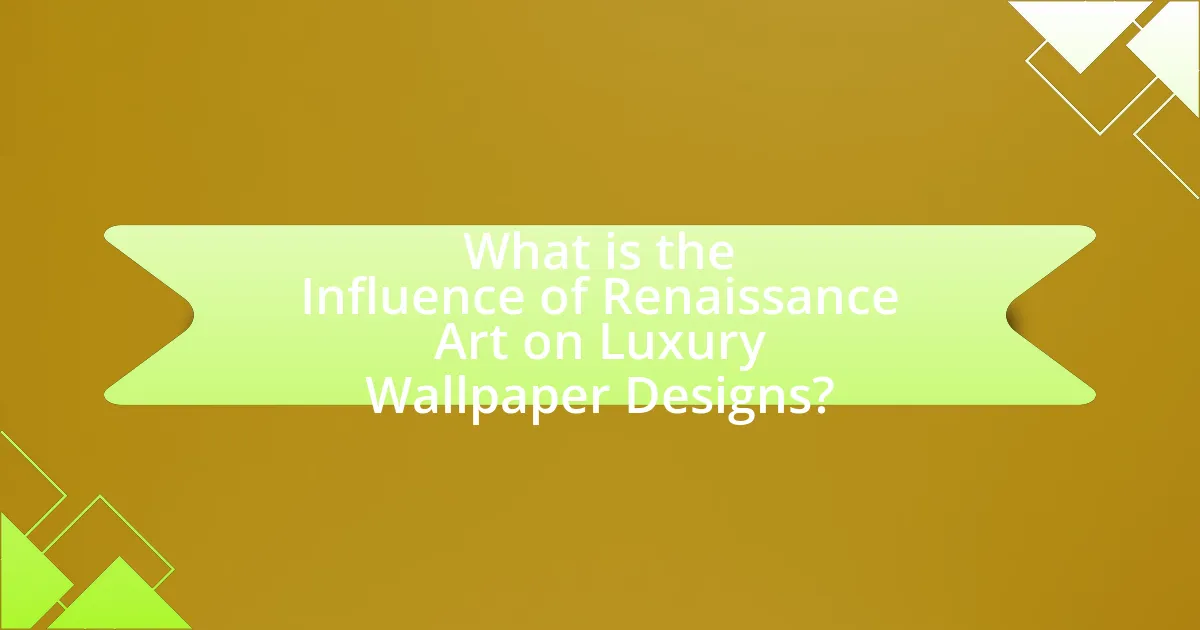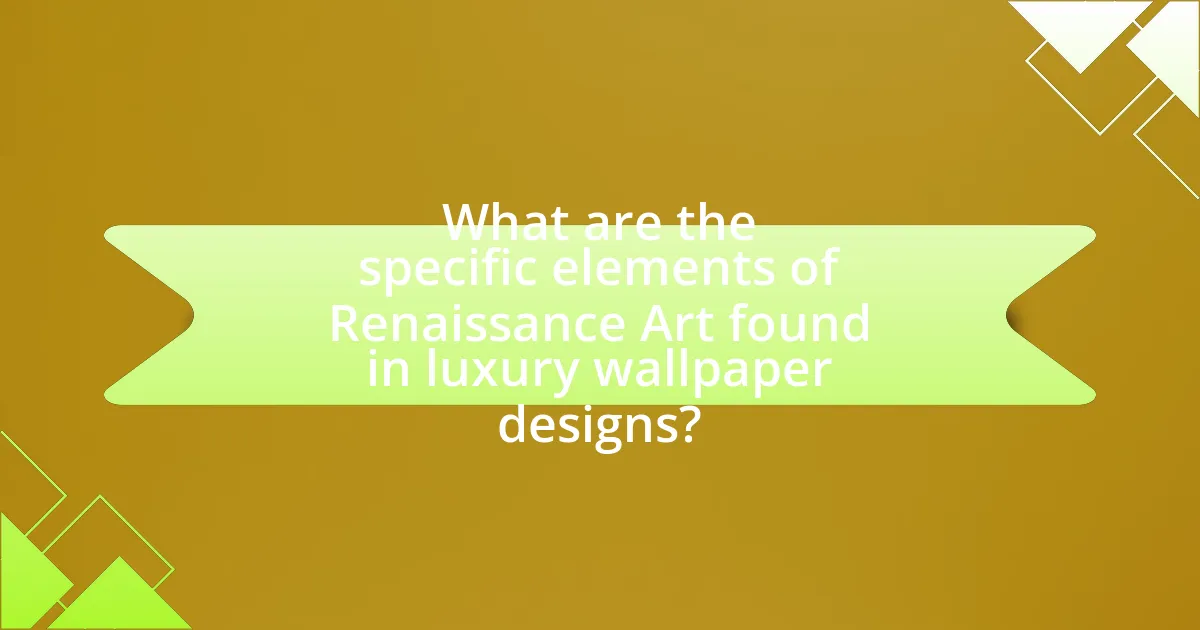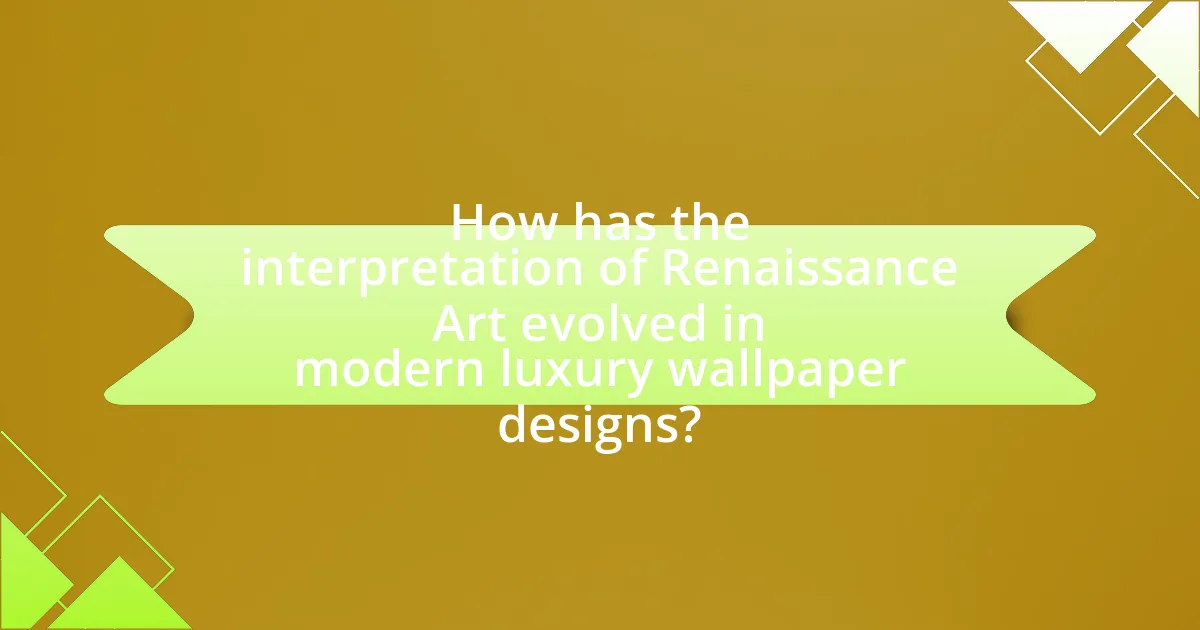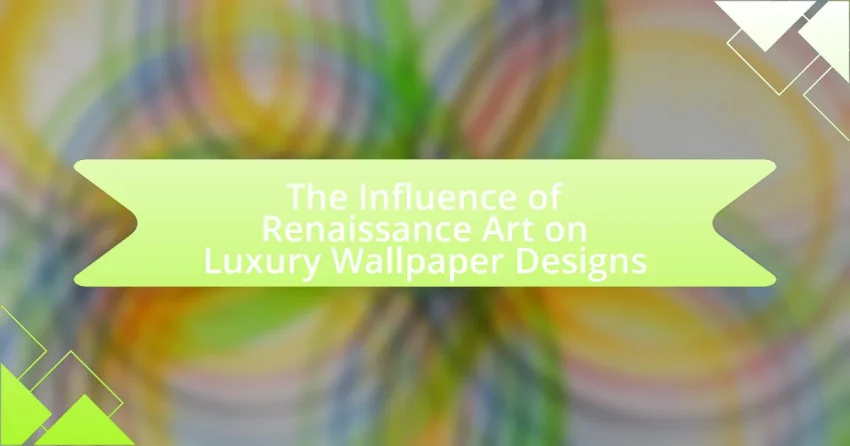The article examines the profound influence of Renaissance art on luxury wallpaper designs, highlighting the incorporation of intricate patterns, rich colors, and classical themes that reflect the artistic styles of masters like Raphael and Michelangelo. It discusses how key characteristics of Renaissance art, such as perspective, naturalism, and ornamentation, shape the aesthetics of modern wallpaper, while also exploring the significance of color palettes and motifs derived from this historical period. Additionally, the article addresses the evolution of these designs in contemporary contexts, the role of technology in production, and practical tips for homeowners looking to integrate Renaissance-inspired wallpaper into their interiors.

What is the Influence of Renaissance Art on Luxury Wallpaper Designs?
Renaissance art significantly influences luxury wallpaper designs through its emphasis on intricate patterns, rich colors, and classical themes. The revival of classical antiquity during the Renaissance led to the incorporation of motifs such as floral designs, mythological figures, and architectural elements into wallpaper, reflecting the artistic styles of masters like Raphael and Michelangelo. This influence is evident in the use of detailed imagery and opulent color palettes that characterize luxury wallpapers, which often aim to evoke the grandeur and sophistication associated with Renaissance aesthetics. Historical examples include the use of damask and brocade patterns in wallpaper that mirror the textiles of the period, showcasing the enduring legacy of Renaissance art in contemporary design.
How did Renaissance Art shape the aesthetics of luxury wallpaper?
Renaissance Art significantly shaped the aesthetics of luxury wallpaper by introducing intricate designs, rich colors, and themes inspired by nature and mythology. Artists like Raphael and Michelangelo emphasized realism and perspective, which influenced wallpaper patterns to incorporate depth and dimensionality. The use of motifs such as floral arrangements, classical architecture, and allegorical figures became prevalent in wallpaper designs, reflecting the grandeur and sophistication of Renaissance interiors. This artistic movement also popularized the use of luxurious materials and techniques, such as gilding and embossing, which enhanced the opulence of wallpaper, making it a key element in the decoration of affluent spaces during and after the Renaissance period.
What are the key characteristics of Renaissance Art that influence wallpaper design?
The key characteristics of Renaissance Art that influence wallpaper design include the use of perspective, naturalism, and intricate ornamentation. Perspective in Renaissance Art allows for depth and dimension, which translates into wallpaper designs that create a sense of space and realism in interiors. Naturalism, characterized by lifelike representations of human figures and nature, inspires wallpaper patterns that feature realistic floral and botanical motifs, enhancing the organic feel of a room. Intricate ornamentation, often seen in Renaissance architecture and painting, influences wallpaper through elaborate designs and borders that add elegance and sophistication to wall coverings. These characteristics collectively reflect the Renaissance emphasis on beauty, harmony, and the celebration of the natural world, making them integral to luxury wallpaper design.
How do color palettes from the Renaissance period impact modern wallpaper?
Color palettes from the Renaissance period significantly influence modern wallpaper by introducing rich, vibrant hues and intricate patterns that evoke historical artistry. The Renaissance era is characterized by its use of deep colors like burgundy, emerald green, and gold, which are now frequently incorporated into contemporary wallpaper designs to create a sense of luxury and depth. For instance, the revival of damask and brocade patterns in modern wallpaper reflects the ornate textile designs popular during the Renaissance, showcasing how historical aesthetics continue to shape current trends. This connection is evident in the work of designers who draw inspiration from Renaissance artworks, ensuring that the color schemes and motifs resonate with the opulence of that time, thereby enhancing the visual appeal of modern interiors.
Why is Renaissance Art significant in the context of luxury interior design?
Renaissance Art is significant in the context of luxury interior design because it embodies the principles of beauty, proportion, and harmony that are essential in creating opulent spaces. This art movement, which flourished from the 14th to the 17th century, introduced techniques such as linear perspective and chiaroscuro, enhancing the visual depth and richness of interiors. The use of intricate patterns, vibrant colors, and classical motifs in Renaissance Art has directly influenced luxury wallpaper designs, allowing for the creation of sophisticated environments that reflect wealth and status. Historical examples, such as the lavish frescoes in the Palazzo Ducale in Venice, demonstrate how Renaissance aesthetics can transform interior spaces into works of art, making them a cornerstone of luxury design.
What historical events contributed to the popularity of Renaissance Art in interiors?
The popularity of Renaissance Art in interiors was significantly influenced by the rise of humanism, the patronage of wealthy families, and the rediscovery of classical antiquity. Humanism, which emphasized the value of individual experience and the study of classical texts, led to a cultural shift that celebrated art and learning. Wealthy patrons, such as the Medici family in Florence, commissioned artists like Michelangelo and Botticelli, thereby integrating art into domestic spaces. Additionally, the rediscovery of classical antiquity during the Renaissance inspired artists to incorporate classical themes and techniques into their work, making these artworks desirable for interior decoration. This combination of cultural, economic, and intellectual factors solidified the role of Renaissance Art in enhancing the aesthetic appeal of interiors.
How does Renaissance Art reflect the values of luxury and opulence?
Renaissance Art reflects the values of luxury and opulence through its emphasis on intricate detail, rich colors, and the portrayal of affluent subjects. Artists like Leonardo da Vinci and Michelangelo utilized expensive materials such as gold leaf and vibrant pigments, which were symbols of wealth during the period. The depiction of lavish settings, elaborate clothing, and ornate architecture in works like “The Last Supper” and the Sistine Chapel ceiling further illustrates the era’s celebration of grandeur and sophistication. Additionally, the patronage of wealthy individuals and institutions, such as the Medici family, underscores the connection between art and economic power, reinforcing the notion that art was a vehicle for displaying status and luxury.

What are the specific elements of Renaissance Art found in luxury wallpaper designs?
Specific elements of Renaissance Art found in luxury wallpaper designs include intricate patterns, classical motifs, and a focus on perspective and depth. These designs often incorporate elements such as floral and botanical themes, which reflect the naturalism prevalent in Renaissance paintings. Additionally, the use of rich colors and textures in wallpaper mimics the opulence of Renaissance interiors, while the incorporation of mythological and historical figures draws directly from the artistic themes of the period. The attention to detail and craftsmanship in luxury wallpaper designs echoes the techniques used by Renaissance artists, such as chiaroscuro and sfumato, enhancing the overall aesthetic and historical resonance of the decor.
Which motifs from Renaissance Art are commonly used in wallpaper?
Common motifs from Renaissance Art that are frequently used in wallpaper include floral patterns, mythological scenes, and architectural elements. Floral patterns often draw inspiration from the intricate botanical designs found in works by artists like Albrecht Dürer, while mythological scenes reflect the themes of classical antiquity, as seen in the frescoes of Raphael. Architectural elements, such as columns and arches, are also prevalent, echoing the grandeur of Renaissance architecture exemplified by structures like St. Peter’s Basilica. These motifs not only enhance the aesthetic appeal of wallpaper but also connect contemporary designs to the rich artistic heritage of the Renaissance period.
How do floral and botanical designs from the Renaissance period appear in wallpaper?
Floral and botanical designs from the Renaissance period appear in wallpaper through intricate patterns that reflect the natural world, often featuring stylized flowers, leaves, and vines. These designs are characterized by their vibrant colors and detailed representations, which were inspired by the botanical studies and art of the time. For instance, the use of motifs such as tulips, roses, and other flora in wallpaper can be traced back to Renaissance artists who emphasized realism and beauty in their work, as seen in the tapestries and paintings of that era. The revival of these designs in wallpaper during the 18th and 19th centuries further solidified their influence, as manufacturers sought to replicate the elegance and sophistication of Renaissance aesthetics in interior decor.
What role do mythological themes play in luxury wallpaper inspired by Renaissance Art?
Mythological themes serve as a significant source of inspiration in luxury wallpaper designs influenced by Renaissance Art, reflecting the era’s fascination with classical mythology. These themes often manifest through intricate depictions of gods, goddesses, and mythological narratives, which were prevalent in Renaissance artworks, such as those by Botticelli and Raphael. The incorporation of these elements not only enhances the aesthetic appeal of the wallpaper but also evokes a sense of historical richness and cultural depth, aligning with the Renaissance ideals of beauty and humanism. For instance, the use of motifs like Venus or Apollo in wallpaper designs connects contemporary spaces to the grandeur of Renaissance artistry, reinforcing the timeless allure of mythological storytelling in decorative arts.
How do textures and materials in luxury wallpaper reflect Renaissance influences?
Textures and materials in luxury wallpaper reflect Renaissance influences through the use of rich fabrics, intricate patterns, and opulent finishes. The Renaissance period emphasized artistry and craftsmanship, leading to wallpapers that often feature brocade, damask, and silk, which were popular during that era. These materials not only provide a tactile richness but also showcase elaborate designs inspired by classical motifs, such as floral patterns and architectural elements, reminiscent of Renaissance art. For instance, the revival of gold leaf and metallic inks in wallpaper design mirrors the gilded surfaces found in Renaissance paintings and frescoes, reinforcing the connection between the two.
What types of materials are used in luxury wallpapers that draw from Renaissance techniques?
Luxury wallpapers that draw from Renaissance techniques typically utilize materials such as silk, velvet, and hand-painted paper. These materials reflect the opulence and craftsmanship characteristic of the Renaissance period, where intricate designs and rich textures were paramount. For instance, silk wallpapers often feature elaborate patterns and gold leaf accents, reminiscent of the luxurious fabrics used in Renaissance art and fashion. Velvet, with its depth and richness, adds a tactile quality that echoes the sumptuousness of Renaissance interiors. Hand-painted paper allows for bespoke designs that can replicate the detailed artistry found in Renaissance frescoes and tapestries, ensuring that each piece is unique and reflective of historical artistry.
How do texture and layering in wallpaper mimic Renaissance artistic methods?
Texture and layering in wallpaper mimic Renaissance artistic methods by employing techniques that replicate the depth and richness characteristic of Renaissance paintings and frescoes. Renaissance artists often used layering to create a sense of three-dimensionality, utilizing glazes and textures to enhance visual complexity. Similarly, modern wallpaper designs incorporate multiple layers of materials and finishes, such as embossed patterns and metallic inks, to achieve a tactile quality and depth reminiscent of the intricate details found in Renaissance art. This approach not only reflects the aesthetic principles of the period but also engages viewers in a sensory experience akin to that of observing a Renaissance masterpiece.

How has the interpretation of Renaissance Art evolved in modern luxury wallpaper designs?
The interpretation of Renaissance Art in modern luxury wallpaper designs has evolved to emphasize a blend of historical authenticity and contemporary aesthetics. Designers now incorporate intricate motifs, vibrant colors, and classical themes inspired by Renaissance masterpieces, adapting them to fit modern tastes and interior styles. For instance, the use of digital printing technology allows for the reproduction of detailed artworks, such as those by Botticelli or Michelangelo, on wallpaper, making these historical elements accessible and relevant in today’s decor. This evolution reflects a growing trend where luxury wallpaper serves not only as a decorative element but also as a medium for storytelling and cultural appreciation, bridging the gap between past and present.
What contemporary trends are influenced by Renaissance Art in wallpaper design?
Contemporary trends in wallpaper design influenced by Renaissance Art include the use of intricate patterns, rich color palettes, and classical motifs. Designers often draw inspiration from the detailed frescoes and tapestries of the Renaissance period, incorporating elements such as floral designs, mythological themes, and ornate borders. For instance, the revival of damask patterns and the use of gold and jewel tones reflect the opulence characteristic of Renaissance interiors. Additionally, modern wallpaper collections frequently feature digital reproductions of famous Renaissance artworks, allowing for a blend of historical significance with contemporary aesthetics. This fusion not only honors the artistic legacy of the Renaissance but also caters to current consumer preferences for unique and luxurious home decor.
How do modern designers reinterpret traditional Renaissance motifs?
Modern designers reinterpret traditional Renaissance motifs by integrating contemporary aesthetics and innovative materials while maintaining the essence of the original designs. For instance, they often simplify intricate patterns and use bold color palettes to create a fresh visual impact, making these motifs more accessible and relevant to today’s consumers. This approach is evident in luxury wallpaper designs that draw inspiration from Renaissance art, such as floral patterns and classical figures, yet present them in a way that aligns with modern interior design trends. The use of digital printing technology allows for greater customization and detail, further bridging the gap between historical art and contemporary design.
What innovations in technology have changed the production of Renaissance-inspired wallpaper?
Digital printing technology has significantly transformed the production of Renaissance-inspired wallpaper. This innovation allows for high-resolution images and intricate designs to be printed directly onto wallpaper materials, enabling the reproduction of detailed Renaissance art with precision and vibrancy. Additionally, advancements in eco-friendly inks and materials have made it possible to create wallpapers that are both visually stunning and sustainable, aligning with modern environmental standards. The use of computer-aided design (CAD) software further enhances the ability to customize patterns and colors, making it easier for designers to create unique, personalized wallpaper that reflects the rich aesthetics of the Renaissance period.
How can homeowners incorporate Renaissance-inspired luxury wallpaper into their spaces?
Homeowners can incorporate Renaissance-inspired luxury wallpaper into their spaces by selecting designs that feature intricate patterns, rich colors, and historical motifs characteristic of the Renaissance period. These wallpapers often include elements such as floral designs, classical architecture, and mythological themes, which can enhance the aesthetic of a room. For instance, using a wallpaper with a fresco-style print can create a dramatic focal point in a living room or dining area, reflecting the grandeur of Renaissance art. Additionally, pairing these wallpapers with period-appropriate furnishings and decor can further immerse the space in the Renaissance style, creating a cohesive and luxurious environment.
What tips can help in selecting the right Renaissance-inspired wallpaper for a room?
To select the right Renaissance-inspired wallpaper for a room, prioritize designs that reflect authentic Renaissance motifs such as intricate patterns, rich colors, and classical themes. Look for wallpapers that feature elements like floral designs, mythological figures, or architectural details reminiscent of Renaissance art, which flourished from the 14th to the 17th century. Ensure the wallpaper complements the room’s existing decor and color scheme, as Renaissance art often emphasizes harmony and balance. Additionally, consider the texture and material of the wallpaper; options like silk or textured vinyl can enhance the luxurious feel associated with Renaissance aesthetics.
How can color and pattern choices enhance the overall aesthetic of a space with luxury wallpaper?
Color and pattern choices significantly enhance the overall aesthetic of a space with luxury wallpaper by creating visual harmony and depth. Specific color palettes can evoke emotions and set the mood; for instance, warm tones like gold and burgundy can create a sense of opulence, while cooler shades like blue and green can promote tranquility. Patterns inspired by Renaissance art, such as intricate florals or geometric designs, add texture and interest, drawing the eye and making the space feel more dynamic. Historical context shows that Renaissance artists often used color and pattern to convey themes of beauty and nature, which can be reflected in modern luxury wallpaper designs, thereby enriching the aesthetic experience of the space.
